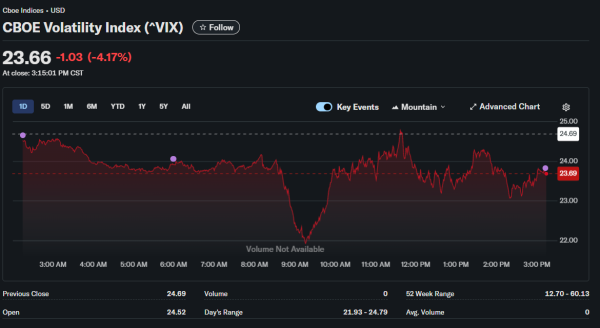Financial markets worldwide experienced severe turbulence as major equity benchmarks tumbled amid heightened economic uncertainty. The synchronized selloff impacted stocks, bonds, and commodities all at once. Senior market analysts at Unirock Gestion investigate the catalysts behind this market disruption and what it means for portfolio positioning.
Capital rushed into safer assets as volatility measures surged to heights unseen in recent months. This wasn’t just one sector or region having problems. The breadth and depth of selling revealed something bigger: a complete reassessment of risk across global markets.
Equity Markets Crumble Across the Board
Leading stock indexes suffered substantial losses as selling intensified throughout trading hours. Technology benchmarks dropped particularly hard, declining more severely than diversified market measures. Innovation companies faced harsh treatment as investors reconsidered valuations against shifting interest rate assumptions.
Banking shares encountered fierce selling tied to asset quality worries and lending concerns. Smaller regional banks saw dramatically pronounced weakness, reviving anxieties about earlier sector difficulties. The spreading fear pressured even larger, better-capitalized institutions, suggesting systemic concerns rather than isolated problems.
Energy stocks couldn’t avoid the broad downdraft despite relatively steady oil prices. The comprehensive selling across all sectors implied macroeconomic worries trumping individual business fundamentals. Even historically stable defensive areas like utilities and consumer staples registered declines, eliminating traditional hiding places.
Bond Markets Flash Warning Signals
Government bond yields displayed erratic behavior as capital sought refuge in sovereign debt. The 10-year yield initially retreated as money entered safe-haven positions. However, yields subsequently jumped higher as inflation concerns reemerged and central bank policy ambiguity lingered.
Corporate credit spreads expanded meaningfully, signaling mounting worry about business health. Investment-grade bonds saw spreads widen versus comparable government securities. Lower-rated debt experienced substantially more dramatic expansion as risk aversion strengthened, creating a tiered flight to quality.
The yield curve shifted repeatedly throughout trading, mirroring contradictory interpretations about growth and inflation. Some observers saw the instability as proof of confusion about Federal Reserve actions. When bond traders can’t agree on baseline scenarios, equity investors rarely find a stable footing.
Currency Markets Reveal Dollar Dilemma
The dollar showed inconsistent results versus peer currencies as traders evaluated opposing factors. Early dollar strength reflected protective demand during equity liquidation. However, uncertainties about American economic health and Fed direction later undermined the currency, creating whipsaw moves.
European currencies faced distinct obstacles amid questions about regional economic outlook. The euro struggled against the dollar despite Europe’s relatively steady readings. Sterling experienced weakness as British concerns supplemented broader market nervousness.
Emerging market currencies absorbed meaningful pressure as investment flows reversed direction. Investors pulled capital from higher-risk territories, pursuing safety in developed economies. This repatriation generated strain for nations dependent on foreign funding, potentially creating conditions for sovereign stress.
Fear Gauges Hit Multi-Month Peaks
Market anxiety indicators jumped dramatically as selling gathered force. The VIX leaped to multi-month peaks. Derivatives markets reflected surging appetite for downside hedging as investors rushed to protect portfolios against further declines.
Trading volumes climbed substantially beyond recent norms, showing extensive involvement in the selloff. The amplified activity implied authentic positioning adjustments rather than liquidity problems. Brokers encountered obstacles in maintaining orderly trading amid fierce selling intensity.
Intraday volatility touched extreme levels with major indexes oscillating through broad price ranges. These violent swings created complications for automated trading systems and trend-following strategies. Multiple circuit breakers were activated on particular securities experiencing exceptional turbulence, a mechanism reserved for genuine distress events.
Sector Performance Tells a Story
While most industries declined, the magnitude varied considerably across sectors. Technology and consumer discretionary areas led the downturn, falling sharpest. These growth-sensitive segments proved most exposed to evolving rate assumptions and economic worries.
Healthcare equities showed comparative steadiness, declining less than broader market gauges. Investors regarded the sector’s defensive qualities as appealing amid uncertainty. Drug makers and healthcare providers demonstrated noteworthy strength, offering clues about where defensive capital sought shelter.
Commodities Mirror Risk-Off Sentiment
Commodity markets mirrored the risk-avoidance attitude dominating financial markets broadly. Industrial metals tumbled sharply on demand worries. These economically sensitive materials frequently function as forward indicators of manufacturing momentum, and their weakness suggests traders anticipate slowing activity.
Precious metals displayed conflicting performance as competing influences clashed. Gold initially rallied on safe-haven demand but later retreated as the dollar strengthened. Silver, given its industrial uses, declined more dramatically, reflecting growth concerns rather than pure haven dynamics.
What Comes Next
The path forward hinges on numerous developing factors, including economic data, earnings reports, and policy decisions. Near-term uncertainty seems elevated given contradictory signals. Investors face portfolio positioning challenges amid genuine ambiguity about probable outcomes.
Some observers view the selloff as creating attractive entry opportunities for long-term investors. Others warn that additional deterioration may occur before conditions stabilize. The reality probably depends on how fundamentals evolve over the coming weeks.
Many financial analysts note that moments of maximum fear often create the most attractive long-term entry points. However, distinguishing temporary panic from justified concern requires careful analysis of underlying conditions. Simply buying the dip mechanically without assessing fundamentals rarely produces optimal results during genuine market stress periods.











